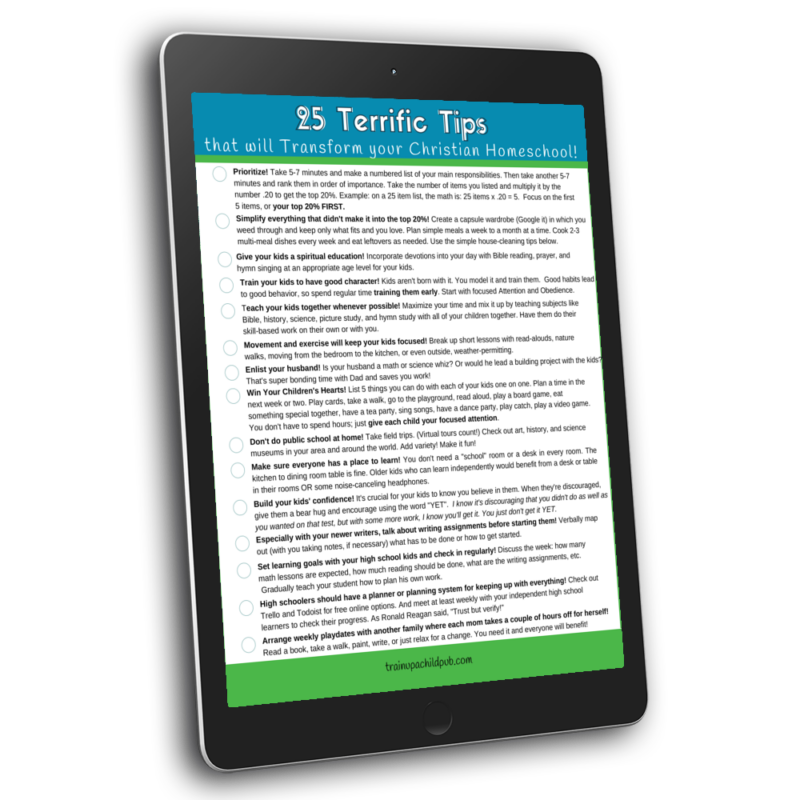5 Steps to starting your homeschool with a bang!

It’s back to homeschool time! Whether you’re starting homeschooling for the first time, are an experienced homeschool mom, or just need a midyear homeschool reboot, try these 5 steps to starting your homeschool with a bang!
- 5 steps to starting your homeschool with a bang!
- 1. Start your homeschool with enthusiasm!
- 2. Plan something exciting on the first day of your homeschool semester (or make homeschooling more fun anytime).
- 3. Create a Routine.
- 4. Teach your older kids to be more independent by helping them learn to plan their own work.
- 5. Homeschool more effectively by learning brain-based teaching tips to help your kids retain more of what they learn.
5 steps to starting your homeschool with a bang!
You spent hours deciding on your curriculum and may have ordered your books, but you aren’t done yet. Here are a few other crucial steps to hit the ground running and make this your most effective homeschooling semester yet.
1. Start your homeschool with enthusiasm!
YOU set the emotional tone in your home. Your excitement (or lack thereof) for homeschooling will be contagious.
My kids always told me I was “cute” because I was excited about learning new things.
And, if you’re new at home educatiing, let me tell you. You will be learning along with your kids all the way through the homeschool years. So you might as well embrace it and get excited about it.
Your enthusiasm goes a long way toward bringing your kids’ homeschool education to life. Your kids can’t help but pick up on the value you place on education, on books, and on time with them.
And in sharing your committment and love of learning with your kids, you’re giving them the gift that keeps on giving for their entire lives.
Again, it will be clear to them that you enjoy being with them and learning alongside them. Remember, your attitude about them has everything to do with how well they succeed with their homeschool work. Read this If you need to brush up on how to talk to your kids in ways that will encourage and help them believe in themselves.
2. Plan something exciting on the first day of your homeschool semester (or make homeschooling more fun anytime).

Editor’s Note: This post has affiliate links, meaning if you purchase something from one of these links, we might make a small commission at no extra cost to you. A thousand thanks for supporting us in this way! Read more here: Terms and Conditions
3. Create a Routine.
Homeschooling works best when you’re following a plan. You don’t have to plan every hour but have a routine. Get up at about the same time, and have a regular morning routine. Also plan a set lunch time, dinner time, and bedtime. Kids thrive on routines — and so do we.
I’m a big fan of time-blocking. If you’ve never heard of it, it’s looking at your calendar for the week, making sure everything that’s non-negotiable is on there, and then scheduling blocks of time to work on specific tasks.
Make sure to group your errands or save them for a weekend, so you aren’t turning homeschooling into car-schooling. Some of that is fine, but it’s vital to get into a routine at home and make it the exception rather than a rule as you start homeschooling or begin a new semester or year.
In my many years of homeschooling, I’ve seen many people get so caught up in field trips and socializing that they have trouble getting their work done. And I get it!!
It can be hard to stay home most of the time, and loneliness is a real thing for homeschooling moms and moms of littles.
How to plan your weeks using time blocking
Here’s how to plan your weeks using time-blocking. First, grab your calendar (Gmail works great for this) and put in any non-negotiable dates, or dates you know you won’t be homeschooling.
After that, carve out 15 minutes to 2+ hour blocks (depending upon the ages of your kids). You can probably get several time blocks in your calendar in a week.
Example Morning Blocks
A morning block might be a couple of hours with the same routine on most days.
Other Time-blocking tips
⏲ SET AN INTENTION on your calendar for what you want to do in each block. Decide how often you will do language arts, history, science, art, music, etc., and create blocks for those.
⏲ Remember that you don’t have to do every subject every day. Or you have a daily block for math + reading, and one Monday, Wednesday, and Friday for other language arts and history, and Tuesday and Thursday for science. Do what works for you! There’s no rule that homeschooling has to take place during weekdays, either. Use an evening or weekend time if that works better for you.
⏲ It works REALLY well to teach your kids history, science, picture study, and music study together. You can do read alouds, listen to one another’s reports and narrations, even make their own cookie dough maps at the same time.
⏲Timeblocking works best if you leave time in between the blocks for transitions and knocking out other items on your to-do list or that come up. Don’t overplan, but make sure to include at least an hour a week to go over what you plan to do the next week with your kids, list supplies needed, etc.
⏲Don’t forget to add in time for chores and meal prep.
⏲Remember — you’re more likely to follow through if you have a task on a calendar. If you’ve set an intention for a scheduled block of time, it’s a little harder to be indecisive and lose your children’s attention. (Then it’s, Oh well, let’s check out Instagram.)
⏲Use a timer for getting chores done. You’d be surprised at how much faster you and your kids can work with a timer, especially if you are doing household chores! Make it a game. Set the timer for 15 minutes, put on some music, and clean a room with your kids.
⏲If you’ve never used a calendar for time-blocking, you’ll be amazed at how much you can accomplish during your scheduled time blocks, especially if you put your phone on silent and turn it over so you can’t see the screen.
4. Teach your older kids to be more independent by helping them learn to plan their own work.
Middle and high school students should learn to schedule their work within your parameters. For example, if you’re planning 180 days of school and their math book has a certain number of lessons, have them fill in which lesson they’ll be doing each day. Get your high school students a planner to help facilitate this.
You’ll have to work with your older students to break down larger projects , like writing a paper, into smaller assignments until they learn how. (First of all, get used to giving your older kids firm deadlines for when their assignments are due.) Then, teach them how to work backward to set mini-deadlines for when they will have their topic chosen, thesis statement written, research completed, outline written, and so on.
They will use this school planning skill academically and throughout their lives.
And in the short term, it will make your high school years much easier. Teaching your high schoolers to work independently is critical if you have more than a couple of children you are homeschooling!
Also, hang a monthly calendar on the wall, so everyone knows the schedule for everyone else. Make sure to plug in all your regular activities, outside classes, music lessons, co-ops, field trips, church events, service projects, doctor’s appointments, and part-time jobs.
5. Homeschool more effectively by learning brain-based teaching tips to help your kids retain more of what they learn.
This is a biggie. Science says that your kids’ brains can adapt and change themselves according to experiences. This is called neuroplasticity.
We used to think that your brain and mental abilities were completely inherited and you got what you got. But this is not accurate. Research has proved that our brains change as we learn new things and learn to think about things differently.
How exciting is that? And it applies to you, too!
This has huge implications for homeschooling and education, so educate yourself to make the most of this! Check out these links below to learn what you can do to add brain-based teaching methods to your toolbox!
- Brain-based Teaching Tips--this is an introduction post to brain-based teaching for your homeschool. It focuses on how to talk to your children in a way that encourages them to have self-confidence, which greatly affects their academic (and other) performance.
- If your kids are sitting at a desk or in a chair all day doing school, they miss out on an easy boost to their learning retention. Read about how moving their bodies more will give your kids great learning gains.
- Try this quick technique to get your children ready to learn and see the difference it makes.
- This post has two tips about learning – integrating subjects and adding an element of emotion to help to learning stick.
If you want to start your homeschool semester with a bang or give your homeschooling a reboot anytime, add these tips to your routine and please share them with your friends using the sharing buttons below.
Happy Homeschooling!







Great blog post!! This will surely help each and every homeschool mom that reads it.
Thank you for your kind words, Ashley, I appreciate you taking the time to read and comment. 🙂